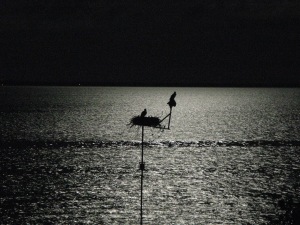Happy last day of June! As you probably know by now, the naming contest was a success. Thanks to the 500 viewers who voted, the chicks finally have names! The oldest now goes by “Breezy” and the youngest is named “Spitz,” after Dr. Spitzer. Many of you seem to have been concerned about Spitz not getting enough food. The Crazy Osprey Family and the Conservancy assured you not to worry and let nature take its course. As we can all see, Spitz is thriving and appears to be well fed. So we hope all of the camera watchers are feeling better now.
A lot of our viewers have posted questions on the Conservancy’s Facebook page. This seems to be a good time to address some of your questions and concerns:
What happened to the third egg?
No one in my family witnessed the removal of the last egg, as we were out of town on the day in question. This is an account sent to the Conservancy from a camera viewer. WARNING: THE FOLLOWING PASSAGE IN ITALICS IS RATHER GRAPHIC-PROCEED AT YOUR OWN RISK
Here’s what I just witnessed. I saw what was happening to the old egg. Audrey was calling loudly for food and finally got off the chicks. All calling for food. Chick #1 had his foot caught in the broken shell. Audrey went flying off but quickly came back with a small piece of fish which she mostly ate. She then went to the broken egg, picked it up and brought it to the side of the nest. I thought she was going to throw it into the water. However, what happened is she started eating what was inside. First it looked like gooey, sticky stuff (excuse my bad terminology). Then a small little chick was drawn out which she tried to eat. It was well developed with head, wings etc. Tried giving bits to the youngsters. It must have been hard to chew or she did not like it as it stayed pretty much whole. Finally, it dropped down far into the outer nest or water after several attempts of eating, dropping and feeding. She really did not like it when the chicks went to eat some.
When Tom wasn’t bringing many fish back to the nest, were there any eagles in the area?
Some of you have raised concern that the reason behind the lack of fish being brought back to the nest was related to eagles competing for the same food source. Although we do see eagles occasionally, we have not seen enough eagles to be a problem.
Where does Tom go when he is not at the nest?
Tom goes many places when he is not on the nest. He enjoys eating on our boatlift or on the electric box near the end of the dock. We also see him on neighbors’ docks and trees to the north and south of us. Sometimes he is standing on the camera, just out of your view.

One of Tom’s favorite hang-outs. He will frequently eat his fish from this electric box at the end of our dock
Why is Audrey so vocal at times?
Most of the cries that we hear are food begging calls. We also hear defensive calls if there are other osprey in the area. If anyone goes onto our dock, Tom and Audrey let us know that they are not happy. Around 3 pm on Sunday, the ospreys were on high alert because our neighbor had his family visiting. There were a lot of children and adults on the dock and in the water making more noise than usual. Tom, Audrey and the chicks were all bothered by the visitors and were especially noisy. A couple mornings ago, an interloper landed on the nest and Tom immediately flew over and chased him off. There was a lot of osprey noise from Tom and Audrey while this was happening.
Which osprey eats first?
It is crucial that Tom eats first. He is the sole provider for the nest and needs the most strength to continue to hunt for fish. This is why we frequently see half eaten fish being returned to the nest; Tom has already eaten his portion. Next to eat is Audrey. Without her, there is no one to protect the babies and the nest. The remainder of the fish goes to the chicks, Breezy and Spitz. It might appear that Breezy gets more food than Spitz, but it is common that the older and therefore biggest chick eats first. This should not raise any distress among our viewers. Yes, it is hard to watch, but that is nature. Breezy had been the bigger and the stronger of the two, so he was more capable of boxing little Spitz out of the way. But don’t worry; Spitz appears to be doing just fine and is catching up in size to Breezy. Over the past couple of weeks, we know that a lot of our viewers wanted us to get food to Spitz. The Conservancy and the Crazy Osprey Family have made a conscious decision not to intervene when nature is taking its course. Last year when Ozzie was caught in the fishing line, we decided to intervene because it was a man-made predicament, not something that would occur by itself in nature.
Remember to send your photos in for the Where in the World are Tom and Audrey contest. Here is our first winner:
Remember, you can click on each of the above photos to enlarge them.
Adios amigos, until next time,
Osprey Girl














